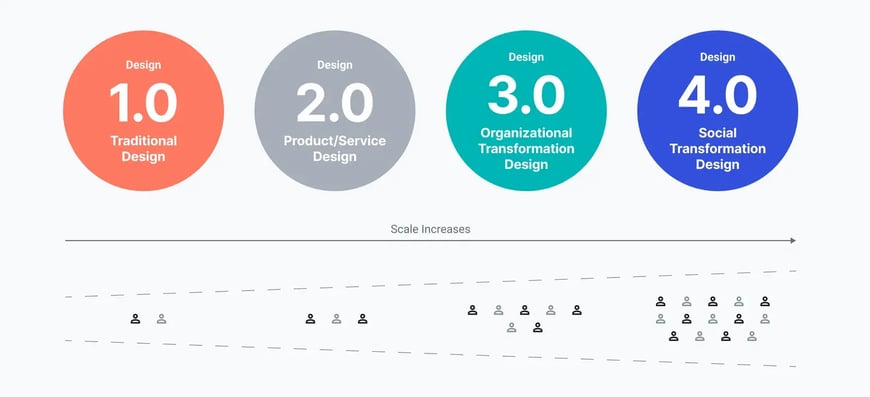We live in a world composed of a multitude of nested systems in constant interaction, with new properties emerging over time. Or, as English poet T. E. Hulme put it, a “concrete flux of interpenetrating intensities.”
Kees Dorst describes the current state of things as hyperconnectivity: “Each of us has become newly connected to innumerable other people. By networking our society, we have inadvertently networked our problems too. The enclosed mini-worlds of our societies, economies, and cultures have been replaced by a tangle of relationships within complex and overlapping networks, where problems cannot be simplified by being split up (the network of relationships is too strong) and power does not rest in one place anymore.”
Likewise, in the natural environment, everything is connected to everything else, whether we recognize it or not. If we do not recognize this interconnectedness, we are likely to fail to see the “forest for the trees.” If so, we are barely able to recognize the larger issues and challenges that arise from interdependency inside and between complex systems. On the contrary, if we can acknowledge the complexity we are part of, it is the first step towards navigating through it.
Role of systems thinking in design
Given this interconnectedness and non-linear causalities in complex systems, it is vital to bear in mind that the products or services we design may lead to unpredictable and long-lasting effects. Every one of us participates in numerous activities that belong to social, economic, and ecological realms. Effectively, we are all parts of multiple systems, and everything we create inevitably becomes a part of multiple systems as well.
This is where adopting a systemic design approach becomes essential. By integrating systemic design thinking into our processes, we can better understand and anticipate the potential impacts of our designs, ensuring they contribute positively to the interconnected systems they will become part of.
Navigating Complexity with Systemic Design
To navigate complexity, it is important to challenge inappropriate and obsolete patterns of thought. In particular, it can be helpful and beneficial to adopt the following viewpoints:
-
Consider the nature of the problems: We live in a complex environment, which implies specific kinds of challenges.
-
Apply profound inquiry: Complex systems encompass different and interdependent levels of inquiry—individual, social, economic, and ecological.
-
Embrace a holistic worldview: The world, as a multitude of nested complex systems, is characterized by interconnectedness, interdependency, emergence, and non-linear causalities.
-
Be mindful about problem-solving: One-off solutions do not work in a complex environment; instead, interventions that create momentum for a situation to head towards a better state are needed.
Complex problem-solving frameworks
As a methodology that allows tackling complexity, an “interdiscipline” called systemic design has emerged. Systemic design integrates systems thinking into design practice, fostering holistic, sustainable, and regenerative outcomes. By adopting a holistic design process, designers from different domains can benefit from systemic design, gaining insights into how to approach problems in a way that acknowledges and leverages the complexity of the systems they are working within. This text aims to explore how designers from different domains can benefit from systemic design.
What is Systemic Design? A Framework for Complex Problem-Solving
I won’t go into the details of what systemic design is. Systemic design is an interdiscipline that integrates systems thinking and design methods to address complex, interconnected problems. It emphasizes scale, relationships, and long-term impacts rather than isolated solutions, to outline briefly. What distinguishes systemic design from other design domains is its focus on scale and complexity. The following picture illustrates this:

Design domains (Jones and van Patter, 2009)
-
Artefact Design: Used as a means for visual communication.
-
Product/Service Design: Focuses on creating value through human-centered design.
-
Organizational Transformation or Strategic Design: Oriented towards organizational structures and strategies.
-
Social Transformation or Systemic Design: Deals with complex social systems, approaching them from a holistic perspective.
These design domains are highly interconnected, and systemic design, as a broader approach, integrates knowledge across all of them.
For more details on systemic design, I recommend starting with Peter Jones’ paper, “Systemic Design Principles for Complex Social Systems.”
The Nature of Today's Problems
Systemic design posits that many of today’s global issues are deeply rooted in the complexity of the systems we interact with. The Anthropocene concept highlights that human activity has a profound impact on these systems, adding layers of complexity through our technological, economic, and organizational networks.
Designing for interconnected systems
To address these challenges effectively, a holistic design approach is essential. This approach emphasizes the importance of understanding the entire system rather than isolated components. By applying systems and design thinking, we can better grasp the interconnected nature of these issues, allowing us to develop solutions that are informed by a comprehensive view of the system and its dynamics.
Kees Dorst, in his seminal work Frame Innovation, identifies several key characteristics of contemporary challenges:
-
Open Problems: These issues lack well-defined boundaries, making it challenging to distinguish what falls within the problem’s scope and what lies outside it. The line between the problem and its context becomes indistinct, complicating efforts to address the issue effectively.
-
Complex Problems: Such problems involve numerous interconnected elements and relationships. The interplay between these elements means that decisions made in one area can have extensive and sometimes unpredictable effects elsewhere.
-
Dynamic Problems: These challenges evolve over time due to ongoing interactions within the system and with external factors. This dynamism leads to the emergence of new elements and the shifting of relationships, making the problem landscape fluid and constantly changing.
-
Networked Problems: These span across multiple organizations and sectors, with extensive interdependencies. The interconnected nature of these issues means that they are difficult to isolate, and changes in one area can have unpredictable impacts on others.
These aspects are crucial for understanding the complexities of today’s problems. However, conventional problem-solving methods do not adequately address such issues because “most of our conventional strategies were conceived to work in a reasonably isolated, static, and hierarchically ordered ‘miniworld’” (Dorst). In reality, we cannot “freeze the world,” simplify the problem situation, apply a one-off solution, and then switch to another problem.
Systemic Design Tools: Multi-Layer Inquiry and Causal Layered Analysis
Causal Layered Analysis (CLA) is a valuable tool within the systemic design methodology. It offers a structured approach to researching complex problems and envisioning alternative futures.
Watch an overview of CLA here.
Causal Layered Analysis (CLA) operates on four levels, each providing a deeper understanding of an issue and integrating diverse sources of knowledge:
-
Litany: Observable events and trends, reflecting public discourse.
-
Structures & Systems: Underlying causes and systemic structures, derived from scientific analysis.
-
Worldview & Values: The deeper paradigms and values shaping structures and behaviors, explored through discourse analysis.
-
Myth: Metaphors or social narratives reflecting collective consciousness and emotional perspectives, represented through art and culture.
The most intriguing aspect is the “Myth” level, also known as the civilizational level of identity. According to Inayatullah, this level reveals deep, collective archetypes and unconscious dimensions of a problem. “These are the deep stories, the collective archetypes—the unconscious and often emotive dimensions of the problem or paradox. This is the root level of questioning.” This level provides insights beyond rational analysis, uncovering foundational elements that are often taken for granted by a society or culture.
CLA is useful at both the analysis and synthesis stages of the design process. By reaching and deconstructing the myth/metaphor level, designers can challenge conventional narratives and develop alternative metaphors. This approach helps ground and align the higher levels—Worldview & Values, Structures & Systems, and Litany—with the newly envisioned future. By integrating systems thinking into the systemic design process, designers can address complex problems with a comprehensive view that embraces the interconnected nature of the issues at hand.
Why a Holistic Worldview Matters in Systemic Design
In the Causal Layered Analysis (CLA) model, one of the key layers is Worldviews. This layer deals with the underlying beliefs and paradigms that support and legitimize the higher levels of the model, such as existing structures and observable issues. As Inayatullah notes, “At this stage, one can explore how different discourses (economic, religious, cultural, etc.) do more than cause or mediate the issue but constitute it. It investigates how the discourse we use to understand is complicit in our framing of the issue.”
Worldviews can be seen as both (1) lenses through which we perceive the world and (2) particular ways of interpreting it. These lenses are often invisible to us until someone points them out. Their power lies in their subtle influence on how problems are defined and approached.
The Systemic Design toolkit offers a valuable technique called Paradoxing to foster a holistic perspective. Complex problems often require considering multiple perspectives across various levels—individual, social, economic, and ecological. It’s tempting to simplify issues by sticking to a single perspective, but this approach can overlook valuable insights. Paradoxing helps to reveal where tensions in a system originate. While paradoxes may seem irreconcilable, both sides of a paradox can be valid simultaneously, much like the concept of Yin and Yang.
In practical application, there is a set of paradox cards, each presenting an “interdependent pair,” as Johnson refers to them.
A paradox card
Paradoxing is a powerful technique because it encourages us to explore and understand situations from multiple, often contradictory perspectives. It advocates for “AND thinking” instead of “OR thinking” (Van Ael). In real systems, contradictions and tensions are integral and must be addressed. Ultimately, both sides of a paradox are true and must be satisfied simultaneously. The whole system can be seen as a dynamic flux of interdependent pairs.
Today’s complex problems have emerged as consequences of collective actions rooted in social paradigms and individual worldviews. As Csikszentmihalyi points out, “Differentiation has produced science, technology, and the unprecedented power of mankind to build up and to destroy its environment. But the complexity consists of integration as well as differentiation.” Our task for the coming decades is to balance differentiation with integration.
A shift from a “lens of separation” to a holistic approach in design is essential. The “lens of separation” views reality as disconnected and fragmented, reflecting a lack of mindful connection with one’s inner life, communities, and the environment. It suggests a belief in superiority—humans over nature, some people over others, and reason over the somatic.
Reason and Goodwin argue that the principle of holism posits that no parts are privileged, and no primary causes define the emergent order. Adopting a holistic lens reveals the world as a complex web of interconnected systems, where everything is in continuous interaction, generating emergent outcomes. It’s our responsibility to reconnect with the world, embracing its complexity and interdependence.
Systemic Wisdom: Rethinking Problem-Solving in Complex Systems
In her influential work, Leverage Points, Donella Meadows introduces a framework for identifying effective intervention strategies within complex systems. She defines a leverage point as a place in a system where a small change can lead to significant impacts. Meadows identifies 12 types of leverage points, each with varying degrees of effectiveness. Another thought-provoking concept from Meadows is “systems wisdom,” or the idea of “dancing with systems,” which extends beyond traditional leverage points.
The core insight is that meaningful system change arises from qualitative shifts, not merely quantitative ones. While many of us rely heavily on numerical metrics, Meadows emphasizes the importance of values that cannot be easily measured, such as justice, democracy, security, freedom, truth, and love. She argues, “No one can precisely define or measure these values. If we do not advocate for them, design systems to produce them, and acknowledge their presence or absence, they may cease to exist.”
Systemic design vs design thinking
Meadows also critiques the industrial mindset’s illusion of control over complex systems. She observes, “We can never fully understand our world in the way reductionistic science leads us to expect.” Despite having 12 types of leverage points, they do not grant us control over complex environments. Predictions and one-off solutions fall short in non-linear, self-organizing, feedback-rich systems. Instead of seeking control, we should focus on designing and redesigning systems. This is where systemic design thinking and a holistic design approach come into play. They emphasize ongoing, iterative interventions rather than static solutions.
Systems thinking encourages us to view problems as part of larger, interconnected systems, requiring a participatory, collaborative engagement with reality. Participation is an evolving process that involves “listening to the wisdom of the system” (Meadows), contemplating what continuously emerges, experimenting, learning from trial and error, and listening again. This approach is akin to playing improvised music rather than following a rigid score.
All in All
The industrial mindset has created specific cultural paradigms—such as economic growth, competition, and consumerism—that have both positive and negative consequences. This reductionist approach often seeks simple, inexpensive, one-off solutions, which eventually lead to a new wave of unpredictable challenges. The root problem lies in our conventional ways of approaching and solving problems.
The world is beautiful in its complexity, where everything is interconnected and interdependent. Complexity cannot be ignored, simplified, or controlled. Navigating complexity requires a “different sort of ‘doing,’” which involves shifting from a fragmented to a holistic worldview. Rather than trying to harness complexity, one should listen to its wisdom, experiment, learn from errors, and start anew. On a practical level, systemic design offers a way to approach this by integrating systems thinking and design methodology.
Systemic design emphasizes a shift in worldview from a reductionist, fragmented perspective to a holistic one. Based on systems thinking, individual influence is broader than we might realize because we all participate in various systems. Consequently, (1) systemic change is unattainable without inner personal transformation, and (2) practitioners from different design domains can both initiate and benefit from this transformation. Systems change comes from within, meaning that individual and planetary well-being are not in opposition but constitute an interdependent pair. What is needed now are actions on different practice levels that consider a larger holistic perspective.
Transform Your Design Strategy Today
Ready to transform your design strategy? Contact us today to discover how our innovative solutions can drive sustainable, regenerative outcomes for your business and the broader ecosystem.
FAQs - Systemic Design Principles
-
Systemic design focuses on understanding and intervening in complex, interconnected systems, while design thinking is more user-centered and problem-specific. Systemic design emphasizes scale, relationships, and long-term system impacts, whereas design thinking often addresses individual challenges with iterative prototyping.
-
Today’s challenges—climate change, healthcare reform, digital transformation—are deeply interconnected. Systemic design helps by analyzing problems across multiple layers (individual, social, economic, ecological), ensuring that solutions don’t just address symptoms but also underlying structures and worldviews.
-
Systemic design encourages designers to see products, services, and organizations as parts of larger ecosystems. By accounting for long-term effects and interdependencies, systemic design supports regenerative outcomes—reducing unintended consequences while fostering resilience and sustainability.
-
Yes. Many organizations adopt systemic design to navigate complexity in markets, supply chains, and internal structures. It enables leaders to anticipate ripple effects, align strategies with broader societal needs, and build adaptive systems that can thrive in changing environments.



